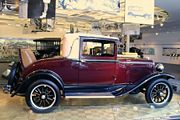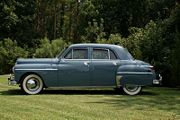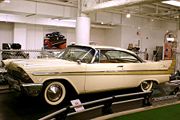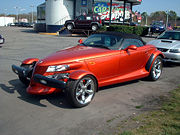Plymouth (automobile)
| Fate | Withdrawn from market (2001); models discontinued or rebranded as Chryslers |
|---|---|
| Founded | 1928 |
| Defunct | 2001 |
| Location | Auburn Hills, Michigan United States |
| Industry | Automobile |
| Products | Cars, minivans |
| Parent | Chrysler |
Plymouth (founded 1928 - dissolved 2001) is a marque of automobile based in the United States, marketed by the Chrysler Corporation and DaimlerChrysler.
Contents |
History
Origins

The Plymouth automobile was introduced on July 7, 1928. It was the Chrysler Corporation's first entry in the low-priced field, which at the time was dominated by Chevrolet and Ford. Plymouths were actually priced a little higher than the competition, but they offered standard features such as external expanding hydraulic brakes that the competition did not provide. Plymouths were originally sold exclusively through Chrysler dealerships. The logo featured a rear view of the Mayflower ship which landed at Plymouth Rock. However, the Plymouth brand name came from Plymouth Binder Twine, chosen by Joe Frazer for its popularity among farmers.[1]
The origins of the first Plymouth can be traced back to the Maxwell automobile. When Walter P. Chrysler took over control of the trouble-ridden Maxwell-Chalmers car company in the early 1920s, he inherited the Maxwell as part of the package. After he used the company's facilities to help create and launch the Chrysler car in 1924, he decided to create a lower-priced companion car. So for 1926 the Maxwell was reworked and re-badged as the low-end Chrysler "52" model. In 1928, the "52" was once again redesigned to create the Chrysler-Plymouth Model Q. The "Chrysler" portion of the nameplate was dropped with the introduction of the Plymouth Model U in 1929.
Great Depression, 1940s, and 1950s


While the original purpose of the Plymouth was simply to cover a lower-end marketing niche, during the Great Depression of the 1930s the car would help significantly in ensuring the survival of the Chrysler Corporation in a decade when many other car companies failed. Beginning in 1930, Plymouths were sold by all three Chrysler divisions (Chrysler, DeSoto, and Dodge). Plymouth sales were a bright spot during this dismal automotive period, and by 1931 Plymouth rose to the number three spot among all cars.
In 1939 Plymouth produced 417,528 vehicles, of which 5,967 were roadsters, or two-door convertibles [2]with rumble seats. The 1939 Roadster was prominently featured at Chrysler's exhibit at the 1939 World's Fair, advertised as the first mass-production convertible with a power folding top. It featured a 201-cubic-inch, 82-horsepower version of the Chrysler Flathead Six engine.
For much of its life, Plymouth was one of the top selling American automobile brands, along with Chevrolet and Ford ("the low-priced three"). Plymouth even surpassed Ford for a time in the 1940s as the second most popular make of automobiles in the U.S.

Through 1956, Plymouth vehicles were known for their durability, affordability and engineering. In 1957, Chrysler's Forward Look styling theme produced cars with much more advanced styling than Chevrolet or Ford, although Plymouth's reputation would ultimately suffer as the cars were prone to rust and sloppy assembly. Because of its new "Forward Look" styling, however, 1957 total production soared to 726,009, about 200,000 more than 1956, and the largest output yet for Plymouth. The marque also introduced its limited production Fury line in 1956, and it too benefited from the crisp Forward Look designs.
Financial/marketing struggles

The Plymouth brand lost market share rapidly in the early 1960s. While Plymouth was a styling leader from 1957 to 1958, its 1959 through 1962 models were awkwardly styled cars that failed to strike a chord with the public. Plymouth also found itself in competition with its own corporate sister division Dodge when the lower-priced, full-size Dodge Dart was introduced for 1960. Rambler, and then Pontiac would assume the number three sales position for the remainder of the decade. Plymouth went into a decline from which it would never fully recover.
The marque regained market share following the introduction of the 1965 models, which returned Plymouth to full-size vehicles and more mainstream styling. Plymouth regained its traditional third place in the sales race in 1971 and 1974, primarily with its popular Valiant and Duster compact models, but as a brand Plymouth was hardest hit by Chrysler's financial woes of the late 1970s. Marketing decisions progressively thinned Plymouth lineup while giving new models to the Dodge and Chrysler brands; by 1979, the Plymouth range consisted of only the domestically produced Volare and Horizon models, and some rebadged Mitsubishi imports.

Despite the introduction of popular models like the 1981 Reliant and 1984 Voyager, Plymouth sales and production numbers continued to decline. Such was the extent of the badge engineering that substantially identical Dodges and Plymouths were being sold at substantially identical prices, eroding the last of Plymouth's market

distinction and quashing any significant reasons for buying one over the other.
Final years
Most Plymouth models offered from the late 1980s onward, such as the Acclaim, Laser, Neon, and Breeze, were badge-engineered versions of Chrysler, Dodge, or Mitsubishi models. Chrysler considered giving Plymouth a variant, to be called the Accolade, of the new-for-1993 full-size LH platform[2], but decided against it. By the late 1990s, only four vehicles were sold under the Plymouth name: the Voyager/Grand Voyager minivans, the Breeze mid-size sedan, the Neon compact car, and the Prowler sports car, which was to be the last model unique to Plymouth.
After discontinuing the Eagle brand in 1998, Chrysler was planning to expand the Plymouth line with a number of unique models before the corporation's merger with Daimler-Benz AG. The first model was the Plymouth Prowler, a modern-day hot rod.

The PT Cruiser was to have been the second. Both models had similar front-end styling, suggesting Chrysler intended a retro styling theme for the Plymouth brand. At the time of Daimler's takeover of Chrysler, Plymouth had no unique models besides the Prowler not also available in the Dodge or Chrysler lines. Further, while all Plymouth dealers also sold the Chrysler line of cars, many Dodge dealers sold only Dodge; it would have caused much greater disturbance to the dealer network to discontinue Dodge than Plymouth. Consequently, DaimlerChrysler decided to drop the make after a limited run of 2001 models. This was announced on November 3, 1999.
The last new model sold under the Plymouth marque was the second generation Neon for 2000-2001. The PT Cruiser was ultimately launched as a Chrysler, and the Prowler and Voyager were absorbed into that make as well. Following the 2001 model year, the Neon was sold only as a Dodge in the US, though it remained available as a Chrysler in Canadian and other markets. The Plymouth Breeze was dropped after 2000, before Chrysler introduced their redesigned 2001 Dodge Stratus and Chrysler Sebring sedan.
Events leading to the demise of Plymouth
- 1960: Dodge introduces the smaller, lower-priced "Dart" series that competes directly with Plymouth's offerings.
- 1961 and 1962:Rambler and then Pontiac assumes third place in industry sales for the remainder of the 1960s.
- 1962: Sales drop dramatically with the introduction of a line of unpopularly-styled, downsized full-size models.
- 1971: Unable to afford to develop its own subcompact, the British Hillman Avenger is imported as the Plymouth Cricket, which is discontinued in mid-1973 due to quality concerns.
- 1974: The Dodge Dart and Plymouth Valiant are, for the first time, different only in name and minor trim details. This identicality continues with the Dodge Aspen and Plymouth Volaré as well as all further passenger car models. The car that would ultimately become the Chrysler Cordoba is reassigned to Chrysler from Plymouth. Last year for Barracuda.
- 1976: Last model year for the Valiant/Duster. First model year for the Volare.
- 1977: The large Gran Fury is discontinued.
- 1978: The mid-size Fury is discontinued at the end of the model year.
- 1979: Plymouth's lineup is reduced to the Horizon and Volaré, and three rebadged Mitsubishi imports.
- 1979/1980: Chrysler makes several thousand more Dodges than Plymouths for the first time. More Plymouths would be made than Dodges for 1981 and 1982, but from then on there will always be more Dodges made than Plymouths.
- 1980: Newport-based Gran Fury introduced. Last year for Volaré.
- 1981: The full-size Gran Fury and Trailduster SUV's last year.
- 1989: The mid-size Gran Fury (Caravelle in Canada) as well as the Reliant are discontinued after this model year. The Reliant is replaced by the Acclaim.
- 1994: The little-advertised Laser sport-compact as well as the popular Sundance and Colt compacts all end production. They are replaced by a single car, the Neon.
- 1995: Plymouth's lineup is at its all time low, just 3 cars: the Acclaim, the Neon, and the Voyager/Grand Voyager. The number will go up to 4 in 1997, with the introduction of the Prowler, but will never get any higher.
- 1996: In an attempt to move Plymouth downmarket, Chrysler makes the redesigned Voyager only available in base and mid-level SE models. All of the higher-end trim levels available on the previous generation can now only be found on the Dodge Caravan.
- 1999: The redesigned 2000 Neon becomes the brand's last new model.
- 2000: The mid-size Breeze ends production. This is also the last year for the Voyager minivan as a Plymouth. All 2000 Voyagers built in December 1999 and beyond are badged as Chrysler Voyagers. In Canada, the redesigned Neon is sold under the Chrysler name, leaving only the Voyager and Prowler in the lineup. Almost 250,000 more Dodges are built than Plymouths for this year.
- 2001: Plymouth's final model year. Only the Neon remains in the Plymouth line. The Prowler becomes a Chrysler. The Breeze is dropped as Chrysler issues the Chrysler Sebring sedan to replace the Chrysler Cirrus. The PT Cruiser is launched as a Chrysler, though it was originally planned to be a Plymouth. The final Plymouth, a Neon, is assembled on June 28, 2001.
Throughout its later years Plymouth's meager advertisement (in relation to Chrysler and Dodge) played a part in the marque's demise.
Plymouth car models
Concept cars
- Plymouth XX 500 was a 1950 concept car.[3]
- Plymouth Explorer, was a 1954 concept coupe.[3]
- Plymouth Belmont, was a 1954 concept roadster.[3]
- Plymouth Cabana was a 1958 concept station wagon, which featured a unique glass roof for the rear portion of the car.[3]
- Plymouth XNR 500 was a 1960 concept sports car.[3]
- Plymouth VIP was a 1965 concept four seater convertible with a unique roof bar from the top of the windshield to the rear deck.[3]
- Plymouth Duster I was a 1969 concept roadster, with a wraparound boat-style windshield. [3]
- Plymouth Slingshot, was a 1988 concept car. [4]
- Plymouth Speedster was a 1989 2-seater concept car.
Former slogans
The Plymouth division went through numerous slogans, including the following:
- "If it's important to you, it's important to Plymouth" (early 1990s)
- "The nine most important words to Plymouth: Satisfy the customer, satisfy the customer, satisfy the customer" (late 1980s)
- "The pride is back, born in America" (mid and late 1980s)
- "Now that's imagination, that's Plymouth!" (late 1970s)
- "Chrysler-Plymouth, coming through!" (mid 1970s)
- "Plymouth is out to win you over this year" (mid-1960s)
- "Plymouth - star of the forward look" (late 1950s)
References
- Kimes, Beverly Rae (Historian and Author) and Clark, Henry Austin, Jr. (Chief of Research) (MCMLXXXIX). Standard Catalog of American Cars, 1805-1942 (Second edition). Krause Publications, Inc. ISBN 0-87341-111-0.
External links
- Plymouth Website Circa Dec. 24,1996 Courtesy of the Internet Archive.
- HowStuffWorks: How Plymouth Cars Work
|
||||||||||||||||||
| Plymouth road car timeline, 1950–1970s, United States market — next » | ||||||||||||||||||||||||||||||
|---|---|---|---|---|---|---|---|---|---|---|---|---|---|---|---|---|---|---|---|---|---|---|---|---|---|---|---|---|---|---|
| Type | 1950s | 1960s | 1970s | |||||||||||||||||||||||||||
| 0 | 1 | 2 | 3 | 4 | 5 | 6 | 7 | 8 | 9 | 0 | 1 | 2 | 3 | 4 | 5 | 6 | 7 | 8 | 9 | 0 | 1 | 2 | 3 | 4 | 5 | 6 | 7 | 8 | 9 | |
| Subcompact | Cricket | Horizon | ||||||||||||||||||||||||||||
| Horizon TC3 | ||||||||||||||||||||||||||||||
| Colt | ||||||||||||||||||||||||||||||
| Compact | Colt | |||||||||||||||||||||||||||||
| Arrow | ||||||||||||||||||||||||||||||
| Valiant | Volaré | |||||||||||||||||||||||||||||
| Mid-size | Belvedere | |||||||||||||||||||||||||||||
| Satellite | Fury | |||||||||||||||||||||||||||||
| Full-size | Deluxe | Concord | Plaza | |||||||||||||||||||||||||||
| Cambridge | Savoy | |||||||||||||||||||||||||||||
| Special Deluxe | Cranbrook | Belvedere | ||||||||||||||||||||||||||||
| Fury | Gran Fury | |||||||||||||||||||||||||||||
| Sports | Duster | Sapporo | ||||||||||||||||||||||||||||
| Barracuda | ||||||||||||||||||||||||||||||
| Road Runner | ||||||||||||||||||||||||||||||
| GTX | ||||||||||||||||||||||||||||||
| SUV | Trailduster | |||||||||||||||||||||||||||||
| Van | Voyager | |||||||||||||||||||||||||||||
| « previous — Plymouth road car timeline, 1970s–2001, North American market | ||||||||||||||||||||||||||||||||
|---|---|---|---|---|---|---|---|---|---|---|---|---|---|---|---|---|---|---|---|---|---|---|---|---|---|---|---|---|---|---|---|---|
| Type | 1970s | 1980s | 1990s | 2000s | ||||||||||||||||||||||||||||
| 0 | 1 | 2 | 3 | 4 | 5 | 6 | 7 | 8 | 9 | 0 | 1 | 2 | 3 | 4 | 5 | 6 | 7 | 8 | 9 | 0 | 1 | 2 | 3 | 4 | 5 | 6 | 7 | 8 | 9 | 0 | 1 | |
| Subcompact | Cricket | Horizon | ||||||||||||||||||||||||||||||
| TC3 | Turismo | |||||||||||||||||||||||||||||||
| Colt | ||||||||||||||||||||||||||||||||
| Compact | Arrow | Sundance | Neon | |||||||||||||||||||||||||||||
| Colt | ||||||||||||||||||||||||||||||||
| Valiant | Volaré | Reliant | ||||||||||||||||||||||||||||||
| Mid-size | Caravelle | Acclaim | Breeze | |||||||||||||||||||||||||||||
| Satellite | Fury | Gran Fury | ||||||||||||||||||||||||||||||
| Full-size | Fury | Gran Fury | Gran Fury | |||||||||||||||||||||||||||||
| Sports | Duster | Sapporo | Laser | |||||||||||||||||||||||||||||
| Barracuda | ||||||||||||||||||||||||||||||||
| Road Runner | Conquest | Prowler | Prowler | |||||||||||||||||||||||||||||
| GTX | ||||||||||||||||||||||||||||||||
| SUV | Trailduster | |||||||||||||||||||||||||||||||
| Pickup | Arrow Truck | Scamp | ||||||||||||||||||||||||||||||
| Minivan | Voyager/Grand Voyager | |||||||||||||||||||||||||||||||
| Van | Voyager | |||||||||||||||||||||||||||||||
|
|||||||||||